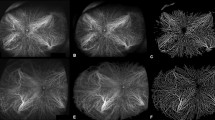Abstract
Purpose
To compare the images of choroidal vasculature obtained by laser speckle flowgraphy (LSFG) and indocyanine green angiography (IA), and to evaluate the imaging of choroidal hemodynamics in eyes with polypoidal choroidal vasculopathy (PCV) using LSFG.
Methods
We performed IA and wide-field LSFG, which measures the index of blood velocity (mean square blur rate; MBR) in 25 eyes with PCV. We constructed an MBR map of the sequential MBR images (600 × 280 pixels) from four or five pulsations during measurement (4.5 s). A grayscale composite map of a still image was obtained by averaging the cumulative sum of the MBR map. We compared the angiographic images of the grayscale composite map to IA results and evaluated the choroidal hemodynamics of 25 eyes with PCV in the MBR map.
Results
The choroidal vasculature on the grayscale map had a resolution similar to the IA results. The grayscale map detected branching network vessels in 20 (80%) of the 25 eyes and polypoidal lesions in 11 (44%) eyes. The MBR map showed that the pulsations of the branching network vessels and polypoidal lesions were synchronized with the cardiac rhythm. The fluctuation rates of the PCV lesions during one pulsation ranged from 8.3% to 26.7% (mean, 13.6%) and from 7.3% to 24.6% (mean, 15.9%) for the intact choroid. The MBR map showed the watershed zone and highest signal intensity in the macula.
Conclusions
Using an MBR map, wide-field LSFG revealed the pulsating choroidal hemodynamics of the posterior fundus. A grayscale composite map showed the fine choroidal vasculature whose resolution was comparable to that of IA. The branching network vessels of PCV showed that pulsation was synchronized with the choroidal vessels. Wide-field LSFG showed the highest choroidal blood flow in the macular area and the presence of a watershed zone.
Similar content being viewed by others
References
Alm A, Bill A. Ocular and optic nerve blood flow at normal and increased intraocular pressure in monkeys (Macaca irus): a study with radioactively labeled microspheres including flow determinations in brain and some other tissues. Exp Eye Res 1973;15:15–29.
Riva CE, Cranstoun SD, Grunwald JE, Petrig B. Choroidal blood flow in the foveal region of the human ocular fundus. Invest Ophthalmol Vis Sci 1994;35:4273–4281.
Fujii H. Visualization of retinal blood flow by laser speckle flowgraphy. Med Biol Eng Comput 1994;32:302–304.
Isono H, Kishi S, Kimura Y, Hagiwara N, Konishi N, Fujii H. Observation of choroidal circulation using index of erythrocytic velocity. Arch Ophthalmol 2003;121:225–231.
Sho K, Takahashi K, Yamada H, et al. Polypoidal choroidal vasculopathy: incidence, demographic features, and clinical characteristics. Arch Ophthalmol 2003;121:1392–1396.
Maruko I, Iida T, Saito M, Nagayama D, Saito K. Clinical characteristics of exudative age-related macular degeneration in Japanese patients. Am J Ophthalmol 2007;144:15–22.
Yannuzzi LA, Sorenson J, Spaide RF, Lipson B. Idiopathic polypoidal vasculopathy (IPCV). Retina 1990;10:1–8.
Konishi N, Fujii H. Real-time visualization of retinal microcirculation by laser speckle flowgraphy. Opt Eng 1995;34:753–757.
Tamaki Y, Araie M, Kawamoto E, Eguchi S, Fujii H. Noncontact, two-dimensional measurement of retinal microcirculation using laser speckle phenomenon. Invest Ophthalmol Vis Sci 1994;35:3825–3834.
Tamaki Y, Araie M, Kawamoto E, Eguchi S, Fujii H. Non-contact, two-dimensional measurement of tissue circulation in choroid and optic nerve head using laser speckle phenomenon. Exp Eye Res 1995;60:373–384.
Tamaki Y, Araie M, Tomita K, Nagahara M, Tomidokoro A, Fujii H. Real-time measurement of human optic nerve head and choroid circulation, using laser speckle phenomenon. Jpn J Ophthalmol 1997;41:49–54.
Konishi N, Tokimoto Y, Kohra K, Fujii H. New laser speckle flowgraphy system using CCD camera. Opt Rev 2002;9:163–169.
Nagahara M, Tamaki Y, Araie M, Fujii H. Real-time blood velocity measurements in human retinal vein using the laser speckle phenomenon. Jpn J Ophthalmol 1999;43:186–195.
Isono H, Kimura Y, Aoyagi K, et al. Safety of laser speckle flowgraphy for retinal application (in Japanese with English abstract). J Eye 1999;16:1731–1735.
American National Standard Institute. Criteria for exposures of eye and skin. In: American National Standard for the Safe Use of Lasers, ANSI Z136.1. New York: American National Standard Institute; 1993. p. 31–34.
Hayreh SS. Segmental nature of the choroidal vasculature. Br J Ophthalmol 1975;59:631–648.
Yuzawa M, Mori R, Kawamura A. The origins of polypoidal choroidal vasculopathy. Br J Ophthalmol 2005;89:602–607.
Author information
Authors and Affiliations
Corresponding author
About this article
Cite this article
Watanabe, G., Fujii, H. & Kishi, S. Imaging of choroidal hemodynamics in eyes with polypoidal choroidal vasculopathy using laser speckle phenomenon. Jpn J Ophthalmol 52, 175–181 (2008). https://doi.org/10.1007/s10384-007-0521-7
Received:
Accepted:
Published:
Issue Date:
DOI: https://doi.org/10.1007/s10384-007-0521-7




